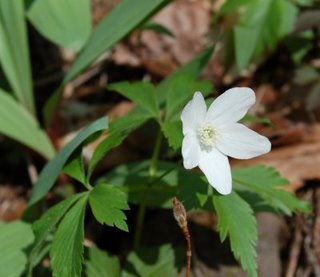Is James Dickey's Deliverance an adventure story set in the land of the nine-fingered people, where musicians are wall-eyed albino idiot-savants, and vicious, toothless hillbillies wait at every turn of the river to sodomize passing strangers? A lot of people think so (and we in Pocahontas County like to bring up the movie whenever we think we can scare off a skier or mountain biker). James Dickey's movie screenplay is set in that Appalachia, but I think his novel is a more complicated work. Dickey drops many hints that Ed's narrative is a pack of lies.
Ed tells us first off that he is an advertising executive--that is, a professional liar, a profit-motivated manipulator of opinion. Then, as Ed describes the unfolding events, he gives us hints that the story is unbelievable.
An old man with a straw hat and workshirt appeared at Lewis' window talking in. He looked like a hillbilly in some badly cast movie, a character actor too much in character to be believed. I wondered where the excitement was that intrigued Lewis so much; everything in Oree was sleepy and hookwormy and ugly, and most of all, inconsequential. Nobody worth a damn could ever come from such a place.
"Too much in character to be believed." The deformed, sickly farmers, each with a murdering relative in prison, the drunken old moonshiner screaming senselessly in the woods--are we meant to believe all this is real? Within a few minutes of pulling the canoe ashore to rest, Ed and Bobby are attacked. (What are the odds that they would pull up into a den of rapists? Or is the river lined on both sides with such men, waiting for tourists?) After Lewis kills one of the cretinous sodomites, Ed and his companions immediately begin to plan what lie they will tell when they reach the end of their trip. While Drew says they should go to the police and tell the truth, the others decide to conceal the body and pretend no rape occurred.
After they upset the canoes in the rapids, where Drew is killed and Lewis severely injured, Ed tracks down and kills the hillbilly he thinks shot Drew and is stalking the others. (Is it the sodomite rapist from upstream? He thinks so, but that man was toothless and unarmed; the man he kills has a rifle and dentures. Did he go home, change his clothes, put in his teeth, and get his gun? Could he have been an innocent bystander? The details of Ed's hunt grow steadily less plausible. And there is only a one in four chance that Drew would be the hillbilly sniper's first victim. How interesting that he was the one who wanted to tell the truth.) Ed conceals the second hillbilly's corpse, along with Drew, and plans the lie he and his friends will tell when they reach town. There are a few hitches, but they bluff their way through. Ultimately, Ed feels that the weekend trip, with all its killing and lying, has given him new resources of personal strength, confidence, and satisfaction.
Why should we believe Ed is telling us the truth, when he's lied to everybody else? What do the men's families know about what happened? Four men with bows and arrows, minimal canoing skills, and a lot of liquor go on a trip in the mountains. Only three of them come home. We really don't need any murderous hillbillies to make such a thing happen. Even the rape, if it happened, need not have involved local people who fortuitously appeared at the very spot chosen for an unplanned rest stop. As an additional flag to question Ed's veracity, Dickey's narrator describes feelings incongruous with his experiences. He despises the rape victim, even fantasizes about shooting him. He feels fulfilled by his successful man-hunt, and returns home to practice his art with renewed enthusiasm. Most people (including Dickey in his war poems) respond to such events with inappropriate hypervigilance, nightmares, guilt, and anxiety.
I don't know what "really" happened on the canoe trip. I wonder if Ed does? Is the ugliness of Appalachia a projection of Ed's (or Dickey's) inner ugliness? Did James Dickey know which of his own stories were true and which were fabrications? Amid these multiple, incompatible versions of people and events, any attempt at certainty would be attractive. Ed says of the map Lewis uses to invite him on the trip:
It was certainly not much from the standpoint of design....there was nothing to call you or stop you on one place or the other. Yet the eye could not leave the whole; there was a harmony of some kind. Maybe, I thought, it's because this tries to show what exists.
















